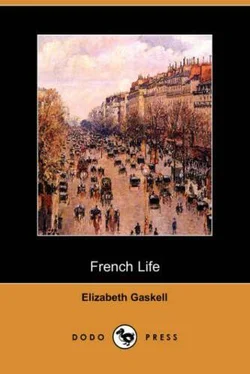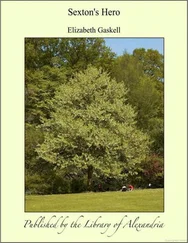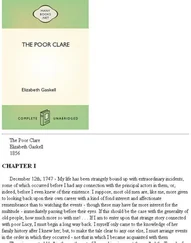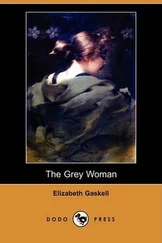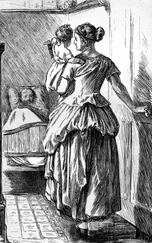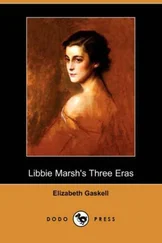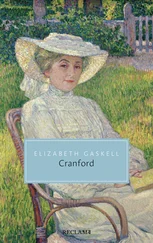May 7 th . - Seeing an apartment to let in the Place Royale, we went over it yesterday. I have always liked the looks of this stately old place ; so full of historical associations too. Then, again, the quietness of it charms me; it is almost like a cloister, for no carriages can come in; and the sheltered walks under the arcades must be very pleasant to the inhabitants on rainy days. The houses are built of very handsome red bricks with stone-facings, and all after the same plan, designed by an architect of the time of Henry IV. - about our Queen Elizabeth's reign; but, if the Place Royale were in England, we should date it, judging from the style of the architecture, a century later at least. It is more like the later additions to Hampton Court. There is a pleasant square in the centre, with a fountain, shady chestnut trees, and gay flower-beds, and a statue of Louis XIII. in the midst. Tradition says, that it was either on this piece of ground, or very near it, that the famous masque took place in the old Palace des Tournelles, when, the dresses of the masquers catching fire, King Charles VI., who was one of them, became mad in consequence of the fright and, it was to soothe his madness, that our present playing-cards were invented.
When first the present place was built, all the fashionable world rushed to secure houses in it. This was the old hotel of the De Rohans; that was Cardinal de Richelieu's before his Palais Cardinal — the present Palais Royal — was completed; in this house Madame de Sévigné was born — and so on, Now, the ground floor, which was formerly occupied by the offices of the great houses above, is turned into shops, ware-houses, and cafés of a modest and substantial kind; and the upper floors are inhabited by respectable and well-to-do people, who do not make the least pretension to fashion. The apartment we went over consisted of five handsome and very lofty reception-rooms, opening out of one another and lighted by many high narrow windows, opening on to a wide balcony at the top of the arcade. One or two of these rooms were panelled with looking-glass, but old-fashioned, in many pieces, not like our modern plates in size. Possibly it was Venetian, and dated from the times of the early proprietors.
The great height of the rooms, as compared to their area, struck me much. Only two or three of the rooms had fireplaces, and these were vast and cavernous. Besides the doors of communication between the rooms, there was, in each, one papered like the walls, opening into a passage which ran the whole length of the apartment. On the opposite side of this passage there were doors opening into the kitchens, store-rooms, servants' bed-rooms, &c. - so small, so close, so unhealthy. Yet in those days there were many servants and splendid dinners. Perhaps, however, some of the lacqueys slept on the upper floor, to which there is now no access from the apartments au premier . At the end of the passage was the bed-room of the late proprietress, with a closet opening out of it for her maid. The bed-room was spacious and grand enough; but the closet-well, I suppose she could lie full length in it, if she was not tall. The only provision for light and air was a window opening on to the passage. We inquired the rent of this apartment: 3000 francs — £120. But perhaps Monsieur le propriétaire might reduce it to 2500 francs — £100. The front-rooms were charming in their old-fashioned stateliness; but, if I lived there, I should be sorely perplexed as to where my servants were to sleep.
May 10 th . - Utterly weary of the noise and heat of Paris, we went out to St. Germain yesterday. I had never been there before; and now, once having been, I want to go again. It is only half-an-hour from Paris by railroad. We could just see Malmaison as we went along, past pretty villas with small gardens brilliant with flowers, as French gardens always are. All the plants seem to 'go into flower; the mass of bloom almost over-balances the leaves. I believe this is done by skilful pruning and cutting-in. For instance, they take up their rose-trees at the beginning of February, and cut off the coarse red suckers and the superfluous growth of root. The hedges to these little suburban gardens are principally made of acacia, and pollard trees of the same species border nearly all the roads near Paris. In the far distance, on the left, almost against the horizon, we saw the famous Aqueduct de Marly, formerly used to conduct a part of the water to Versailles. I do not know what it is in the long line of aqueducts and viaducts which charms one. Is it the vanishing perspective which seems to lead the eye, and through it the mind, to some distant invisible country? or is it merely the association with other aqueducts, with the broken arches of the Claudian aqueduct, stretching across the Campagna, with Nismes, &c.? By means of some skilfully-adjusted atmospheric power, the trains have of late years been conducted up to nearly the level of the terrace at St. Germain's by a pretty steep inclined plane. We went up a few steps on leaving the station, and then we were on the plateau, the castle on our left, and a Place at the entrance to the town on the right.
Nothing could be more desolate-looking than the chateau; the dull-red bricks of which it is built are painted dark-lead colour round the many tiers of windows, the glass in which is broken in numerous places, its place being here and there supplied by iron bars. Somehow, the epithet that rose to our lips on first seeing the colouring of the whole place, was "livid." Nor is the present occupation of the grim old château one to suggest cheerful thoughts. After being a palace, it was degraded to a caserne , or barracks, and from that it has come down to be a penitentiary. All round the building there is a deep dry area, railed round; and now I have said all I can against St. Germain and recorded a faithful impression at first sight. But, two minutes afterwards, there came a lovely slant of sun-light; the sun had been behind a fine thunderous cloud, and emerged just at the right moment, causing all the projections in the chateau to throw deep shadows, brightening the tints in all the other parts, calling out the vivid colours in the flower-beds that surround the railing on the park side of the chateau, and half-compelling us with its hot brilliancy, half luring us by the full fresh green it gave to the foliage, to seek the shelter of the woods not two hundred yards beyond the entrance to the park.
We did not know where we were going to, we only knew that it was shadowed ground; while the "English garden" we passed over was all one blaze of sunlight and scarlet geraniums, and intensely blue lobelias, yellow calceolarias, and other hot-looking flowers. The space below the ancient mighty oaks and chestnut-trees was gravelled over, and given up to nursery-maids and children, with here and there an invalid sitting on the benches. Mary and Irene were bent upon sketching; so we wandered on to find the impossible point of view which is to combine all the excellences desired by two eager sketchers. So we loitered over another hundred yards in the cool shade of the trees. And suddenly we were on the terrace, looking down over a plain steeped in sunlight, and extending for twenty miles and more. We all exclaimed with delight at its unexpectedness; and yet we had heard of the terrace at St. Germain, and associated it with James II. and Maria d'Este all our lives. The terrace is a walk as broad as a street, on the edge of the bluff overhanging the silver tortuous Seine. It is bounded by a wall. just the right height for one to lean upon and gaze and muse upon the landscape below. The mellow mist of a lovely day enveloped the more distant objects then; but we came again in the evening, when all the gay world of St. Germain was out and abroad on the terrace listening to the music of the band; and we could then distinguish the aqueduct of Many on our right, before us the old woods of Vesinet — that ill-omened relic of the ancient forest that covered the Ile de France; and here in the very centre is the star-shaped space called La Table de la Trahison ; here it was that Ganelan de Hauteville planned to betray Roland the Brave and the twelve peers of France, at Roncevaux; and on the very spot the traitors were burnt to death by the order of Charlemagne.
Читать дальше
